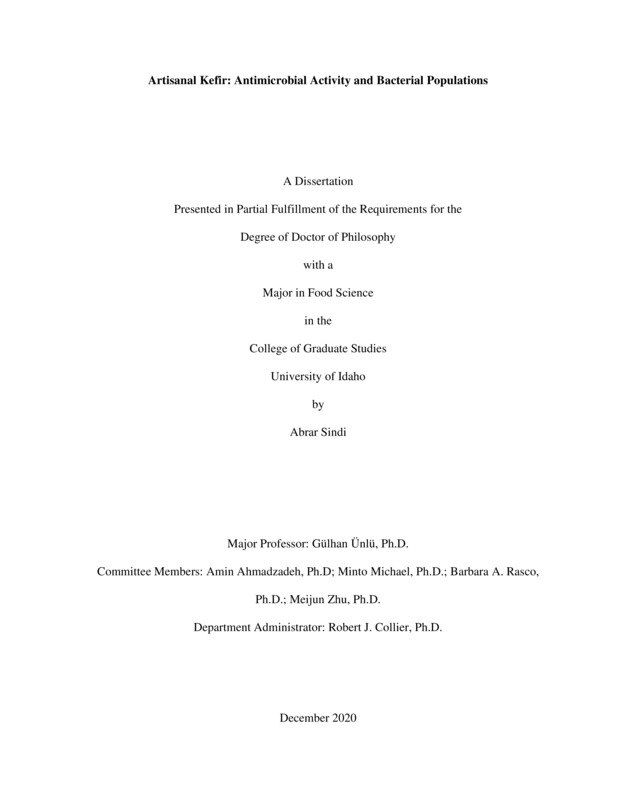Artisanal Kefir: Antimicrobial Activity and Bacterial Populations
sindi, abrar. (2020-12). Artisanal Kefir: Antimicrobial Activity and Bacterial Populations. Theses and Dissertations Collection, University of Idaho Library Digital Collections. https://www.lib.uidaho.edu/digital/etd/items/sindi_idaho_0089e_11987.html
- Title:
- Artisanal Kefir: Antimicrobial Activity and Bacterial Populations
- Author:
- sindi, abrar
- Date:
- 2020-12
- Keywords:
- antimicrobial Bacillus cereus kefir Listeria monocytogenes Salmonella enterica Staphylococcus aureus
- Program:
- Food Science
- Subject Category:
- Food science; Macroecology
- Abstract:
-
Food products can be contaminated by a range of pathogenic and spoilage bacteria. Contamination of foods results in food spoilage and foodborne illnesses and leads to economic losses in the food industry. Similar to chemical antimicrobials, natural preservatives (biopreservatives) can be used to improve food quality and safety. Biologically-based preservation (biopreservation) uses lactic acid bacteria (LAB), their bacteriocins, bacteriophages and bacteriophage-encoded enzymes to ensure food safety and quality for foods that are not fermented. Among biopreservatives, bacteriocins are ribosomally synthesized small antimicrobial proteins, secreted by bacteria to inhibit the growth of other, usually closely related bacteria. Bacteriocins inhibit select pathogenic and/or spoilage bacteria without changing the chemical and physical characteristics of food. Kefir is a fermented dairy product made using kefir grains, which are composed of LAB and yeast in a protein-polysaccharide matrix called kefiran. Kefir has antimicrobial activity due to many metabolic products, including bacteriocins produced by LAB. For this study, it was hypothesized that international artisanal kefirs have diverse microflora, generating distinctive bacteriocin content, resulting in varied levels of antimicrobial activities. The objectives of this work were: 1) compare the antimicrobial activity of artisanal kefirs from Fusion Tea, Britain, the Caucuses region, Ireland, Lithuania, and South Korea against select foodborne pathogens, 2) examine whether the antimicrobial effect is due to bacteriocin production or other antimicrobials present in kefir, and 3) reveal bacterial populations and elucidate the diversity and abundance of LAB species in artisanal kefirs. This dissertation is comprised of two interconnected studies. In the first study, the antimicrobial activities of artisanal kefir products from Fusion Tea (A), Britain (B), Ireland (I), Lithuania (L), the Caucuses region (C), and South Korea (K) were investigated against select foodborne pathogens. Listeria monocytogenes CWD 1198, Salmonella enterica serovar Enteritidis ATCC 13076, Staphylococcus aureus ATCC 25923, and Bacillus cereus ATCC 14579 were inhibited by artisanal kefirs made with kefir grains from diverse origins. Kefirs A, B, and I inhibited all bacterial indicator strains examined at varying levels, except Escherichia coli ATCC 12435 (non-pathogenic, negative control). Kefirs K, L, and C inhibited all indicator strains, except S. aureus ATCC 25923 and E. coli ATCC 12435. Bacteriocins present in artisanal kefirs were determined to be the main antimicrobials in all kefirs examined. Kefir-based antimicrobials are being proposed as promising natural biopreservatives as per the results of the study. A typical kefir microbial community includes LAB, acetic acid bacteria, and yeast among other species in a symbiotic matrix. In the second study, the 16S rRNA gene sequencing was used to reveal bacterial populations and elucidate the diversity and abundance of LAB species in international artisanal kefirs from Fusion Tea, Britain, the Caucuses region, Ireland, Lithuania, and South Korea. Bacterial species found in high abundance in most artisanal kefirs included Lactobacillus kefiranofaciens, Lentilactobacillus kefiri, Lactobacillus ultunensis, Lactobacillus apis, Lactobacillus gigeriorum, Gluconobacter morbifer, Acetobacter orleanensis, Acetobacter pasteurianus, Acidocella aluminiidurans, and Lactobacillus helveticus. Some of these bacterial species are LAB that have been reported for their bacteriocin production capabilities and/or health promoting properties.
- Description:
- doctoral, Ph.D., Food Science -- University of Idaho - College of Graduate Studies, 2020-12
- Major Professor:
- Ünlü, Gülhan
- Committee:
- Ahmadzadeh, Amin ; Michael, Minto ; Rasco, Barbara A; Zhu, Meijun
- Defense Date:
- 2020-12
- Identifier:
- sindi_idaho_0089E_11987
- Type:
- Text
- Format Original:
- Format:
- application/pdf
- Rights:
- In Copyright - Educational Use Permitted. For more information, please contact University of Idaho Library Special Collections and Archives Department at libspec@uidaho.edu.
- Standardized Rights:
- http://rightsstatements.org/vocab/InC-EDU/1.0/

